
Fountain
grasses are versatile garden plants with year-round appeal. Many varieties
reach 4 to 6 feet (1-2 m.) high and can spread up to 3 feet (1 m.) wide, making
most types of fountain grass unsuitable choices for small spaces. However, the
miniature variety called Little Bunny dwarf fountain grass is perfect for tiny
areas.
What is Little Bunny Grass?
Little Bunny dwarf fountain grass (Pennisetum alopecuroides ‘Little Bunny’) is a low-maintenance ornamental with a compact size. This deer-resistant fountain grass reaches 8 to 18 inches (20.5-45.5 cm.) in height with a spread of 10 to 15 inches (25.5-38 cm.). The slow-growing grass is ideal for rock gardens, borders, and small perennial beds – even containers.
Like other types of fountain grass, Little Bunny grows in a
clumping, fountain-like formation. The ribbon-shaped leaves are dark green
throughout the growing season and turn russet gold in the fall. The foliage
remains intact all winter long, which lends structure and texture to the garden
during the dormant season.
In mid to late summer, Little Bunny puts forth an abundance of 3- to 4-inch (7.5-10 cm.) fluffy plumes. The creamy white flowers provide contrast to the dark green foliage and give a soft backdrop for other types of brightly colored flowers in the perennial bed setting. The dried plumes are also attractive in flower arrangements.
Little Bunny Fountain Grass Care
Growing Little Bunny fountain grass is not difficult. This variety of ornamental grass prefers full sun but can tolerate partial shade. Choose an area with good drainage, as the grass does best in moist but not soggy soil. Once mature, bunny grass is drought-tolerant.
Little Bunny is hardy in USDA zones 5 through 9. Due to its
compact size, this variety of fountain grass makes a wonderful container plant.
Try growing Little Bunny fountain grass solo for a graceful, elegant look or in
combination with brighter flowers for the soft texture its plumes lend to the
mixed planting.
When transplanting in the ground, maintain the same soil line as in the pot. Space this variety 10 to 15 inches (25.5-38 cm.) from similarly sized plants. Water thoroughly after transplanting and ensure the soil remains moist for the first four to six weeks while the plant becomes established.
Little Bunny requires little maintenance other than cutting
the old foliage back in early spring before new growth emerges.
When adding as a flowerbed accent plant, consider these other drought-resistant flowers as companions for Little Bunny grass:
Fountain
grasses are versatile garden plants with year-round appeal. Many varieties
reach 4 to 6 feet (1-2 m.) high and can spread up to 3 feet (1 m.) wide, making
most types of fountain grass unsuitable choices for small spaces. However, the
miniature variety called Little Bunny dwarf fountain grass is perfect for tiny
areas.
What is Little Bunny Grass?
Little Bunny dwarf fountain grass (Pennisetum alopecuroides ‘Little Bunny’) is a low-maintenance ornamental with a compact size. This deer-resistant fountain grass reaches 8 to 18 inches (20.5-45.5 cm.) in height with a spread of 10 to 15 inches (25.5-38 cm.). The slow-growing grass is ideal for rock gardens, borders, and small perennial beds – even containers.
Like other types of fountain grass, Little Bunny grows in a
clumping, fountain-like formation. The ribbon-shaped leaves are dark green
throughout the growing season and turn russet gold in the fall. The foliage
remains intact all winter long, which lends structure and texture to the garden
during the dormant season.
In mid to late summer, Little Bunny puts forth an abundance of 3- to 4-inch (7.5-10 cm.) fluffy plumes. The creamy white flowers provide contrast to the dark green foliage and give a soft backdrop for other types of brightly colored flowers in the perennial bed setting. The dried plumes are also attractive in flower arrangements.
Little Bunny Fountain Grass Care
Growing Little Bunny fountain grass is not difficult. This variety of ornamental grass prefers full sun but can tolerate partial shade. Choose an area with good drainage, as the grass does best in moist but not soggy soil. Once mature, bunny grass is drought-tolerant.
Little Bunny is hardy in USDA zones 5 through 9. Due to its
compact size, this variety of fountain grass makes a wonderful container plant.
Try growing Little Bunny fountain grass solo for a graceful, elegant look or in
combination with brighter flowers for the soft texture its plumes lend to the
mixed planting.
When transplanting in the ground, maintain the same soil line as in the pot. Space this variety 10 to 15 inches (25.5-38 cm.) from similarly sized plants. Water thoroughly after transplanting and ensure the soil remains moist for the first four to six weeks while the plant becomes established.
Little Bunny requires little maintenance other than cutting
the old foliage back in early spring before new growth emerges.
When adding as a flowerbed accent plant, consider these other drought-resistant flowers as companions for Little Bunny grass:
